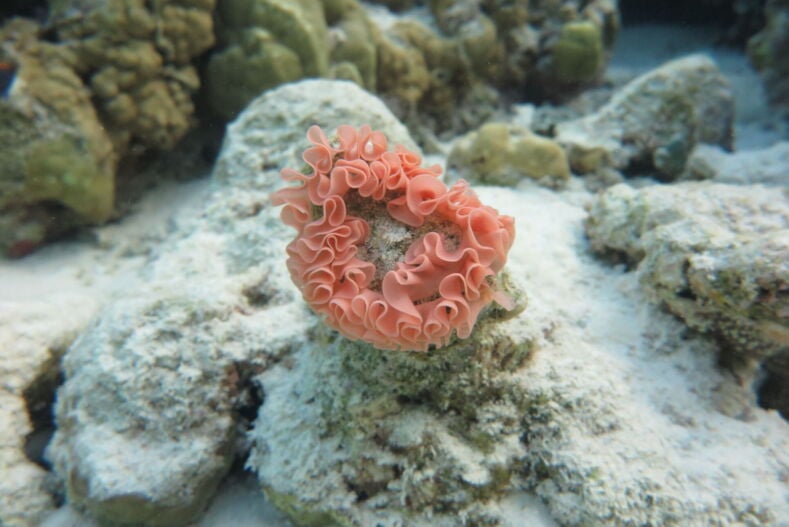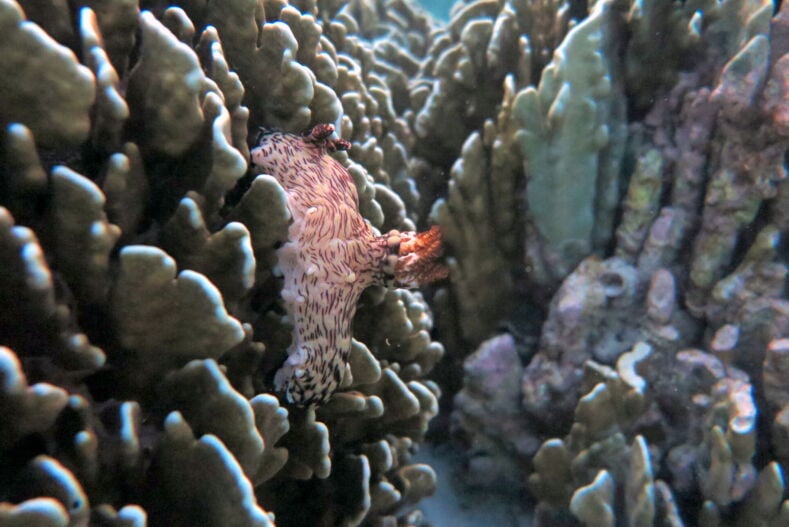If you’ve ever seen something underwater that looked like it could be a living organism, but doesn’t have eyes or what could be interpreted as a mouth, chances are you are looking at some sea creature’s eggs! Pictured below is a nudibranch egg ribbon that we spotted on the coral bommie that we have been transplanting our nursery corals to. At first glance, it may look like somebody has dropped a hot pink hair scrunchie or hung up some party decoration, but looking more closely, you would see that it is actually attached to the reef, and often in an anti-clockwise spiral.

What are nudibranchs?
Nudibranchs (pronounced as ‘noodi-branks’) are sea slugs; a snail without a shell, or more specifically, mollusks belonging to the class of gastropoda. Translated from Latin and Greek, their name actually means ‘naked lungs or gills’; nudus meaning ‘naked’ and brankhia meaning ‘gills’ or ‘lungs. Their name gives you a clue about how these soft-bodied mollusks breathe. The ornate feathery appendages surrounding their anus on their backs are actually their gills… So yes, this means they breathe in the same area where they poop.
Some nudibranchs lack well-defined gills and their oxygen is taken in through specialized tissues that form multiple finger-like appendages that run along their backs in distinctive rows. The appendages are called cerata and are elongated to increase the surface area through which oxygen can be taken up. Cerata come in all shapes, sizes and colours depending on the species and they are what gives nudibranchs a delightful appearance.
There are over 3,000 species and new ones are being discovered all the time. They range in size from a few millimeters to around 30 cm long, weighing over 1 kilogram, and are found all over the world in both cold and warm water. This means you would be able to find them in both your local tide pools back home, frigid European waters and on tropical coral reefs!

Their life cycle
All nudibranchs are hermaphroditic meaning they have both male and female sex organs. This is a really important adaptation for nudis because it is very difficult to find a mate. They move relatively slowly and use their sense of smell and touch to get around. Since the chance of encountering each other is small, they really need to make it count! Some species will lay as many as 25 million eggs, because they will hatch into plankton and become food for filter feeders, such as barnacles and anemones. Being hermaphroditic means that both nudibranch partners will be able to lay eggs, doubling the egg count. After a dance-like courtship, they will fertilise each other’s eggs since they are not able to self-fertilise.
After hatching, the babies look almost identical to their adult counterparts, albeit smaller and with fewer cerata. They can live for a few weeks or up to a year depending on the species.
Have you seen nudibranchs before? You are most likely to encounter them whilst SCUBA diving at Gili Lankanfushi!